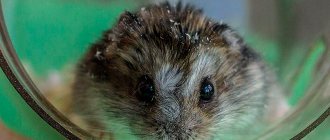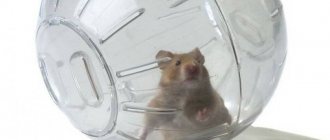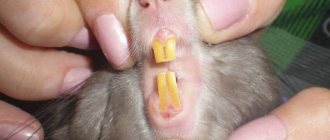The eyes of night rodents are large and convex, which gives them a charming appearance and allows them to notice a predator in time. But physiological exophthalmos (bulging eyes) significantly reduces the protection of the organ of vision. The hamster can easily injure it or prick itself due to a delayed blink reaction. The central zone of the cornea is poorly washed by tears and is little wetted, so even a minor injury can lead to an ulcer. Hamsters are active at night and are not adapted to bright light. A bright flash or direct sunlight can damage hamsters' already weak vision.
Due to the pet’s small size and independent nature, the owner often discovers the problem in an advanced stage: the hamster has one eye closed, or both eyelids are glued together with pus, one is larger than the other, and so on.
Symptoms of the disease
Eye diseases in hamsters can be recognized by the following signs:
- the hamster's eye is very swollen and does not open;
- the eyelid area is always wet and sticks together;
- the hamster's eye waters, a purulent fluid of a grayish or yellowish color is constantly secreted, sometimes with blood;
- a stye or lump may appear;
- inflamed areas become red.
These are clear signs that there is inflammation inside the animal’s small body. This is why a hamster's eyes won't open. A sick pet will behave differently - its activity sharply decreases, it becomes inactive, and sleeps most of the time of the day. During this illness, hamsters may completely refuse to feed and drink.
This may be conjunctivitis, the treatment of which is very complex and lengthy. But often the hamster’s organ of vision turns sour and festers due to other diseases, which are much more difficult to cure. For example, if it’s a cold, the hamster’s eye festers, plus he may sneeze, cough, and wheezing appears in his breathing.
How to deal with this scourge? Our tips and recommendations below will help you with this. But first, we will list the main diseases of the organs of vision in the domestic hamster.
Eye diseases in hamsters
Problems in rodents can be identified by several signs:
- swelling and non-opening of the eyes;
- wet eyelids;
- tearfulness with purulent discharge;
- the appearance of a stye or bump;
- hair loss on the eyelids;
- redness of the inflamed area.
Based on these signs, it can be determined that the animal has a foreign infection. Due to the disease, rodents may stop eating and drinking. All eye ailments are divided into two groups: those resulting from injury and infectious.
Conjunctivitis
This is a disease associated with inflammation of the mucous membrane. This is the most common disease that affects both eyes.
There are several causes of conjunctivitis: infection and infection from another rodent. Without timely treatment, the disease progresses quickly: hamsters have poor spatial orientation, become spreaders of bacteria to other rodents, and may die.
Another reason is an allergy to food or “unhealthy” treats, for example, sweets, baked goods, etc. It is important to give hamsters a special balanced food that does not cause allergic reactions.
The main symptoms of conjunctivitis:
- redness;
- suppuration;
- increased moisture in the eyelids;
- restless behavior of the rodent;
- increase in body temperature;
- sticky eyelids.
If there is at least one symptom of the disease, it is considered that the infection has already entered the body. The discharge of pus indicates a progressive disease. If possible, it is advisable to show your pet to a veterinarian.
For home use, use a proven product - Albucid eye drops. 1 drop in both eyes three times a day. Positive dynamics are monitored from the third day of use. Along with instillation, you can wipe your eyes with a cotton pad once a day. It is not recommended to use other methods and means.
Care during illness:
- periodic change of litter;
- surface disinfection;
- monitoring the condition of the hamster;
- provision of quality food and clean drinking water;
- washing the cage and all rodent accessories.
Blepharitis
The cause of this disease is inflammation. The eyelids turn red and itching occurs. If not treated promptly, both eyes may close. The symptoms are the same as for conjunctivitis, but hair loss around the eye is added.
This is due to the fact that the hamster scratches the affected area. Treatment is similar to the previous disease, only tetracycline ointment is added. The main thing is to provide timely assistance and contact a veterinarian. If you have blepharitis, you need to provide your hamster with a diet and regularly disinfect the cage.
Abscess
If a rodent has a swelling of the eye and there is a clear difference in their size, then it may be an abscess. This disease is popularly called barley.
This is not a disease, but a symptom of shock - a purulent capsule that can hide deep in the hamster's body. The tissues around it become inflamed and become hot compared to other parts of the animal’s body.
Abscess symptoms:
- swelling of the eye;
- mucous discharge;
- inflammation of surrounding tissues;
- itching
The disease can only be cured in a veterinary hospital; it cannot be cured at home. Recovery occurs when the capsule is freed from pus.
Belmo
The disease is associated with the appearance of a light spot on the pupil of a hamster. The main factor is injury, sometimes cataracts. It happens that the stain covers the entire surface of the eye.
A veterinarian's consultation is required to determine the cause. This is a non-infectious disease and cannot be treated with medicine. The rodent will continue to live its usual life, but with a new disadvantage.
To prevent the disease, it is not recommended to place the pet’s cage in the sun and use bedding, which can harm the eyes. It is also not recommended to place hamsters that do not belong to the Djungarian species in the same cage.
Bacterial infections
This does not refer to a separate type of disease, but is a consequence of injury to the eyeball. The infection affects the general condition of the rodent.
Due to damage, bacteria multiply quickly and can penetrate inside the eye. In this case, surgical intervention, including removal, is possible, otherwise the bacterial infection can affect the entire body of the pet, and the hamster will die.
Cataract
This disease is called a metabolic failure in the lens. The end result is blindness. Causes of cataracts: nervousness, injury, old age and other ailments.
Eye drops will not help here, and surgical interventions are not used. The disease cannot be cured, but its occurrence can be prevented. To do this, you need to follow some recommendations:
- the hamster's cage should not be in the sun;
- do not give your pet sweets;
- feed plant foods: carrots, greens, zucchini;
- promptly treat eye diseases.
Glaucoma
This is an increase in the internal pressure of the organs of vision. The disease is accompanied by enlargement and bulging of the eyes, as well as severe pain. The diagnosis can be made by a doctor after measuring blood pressure.
The only treatment is enucleation, which can prevent severe pain. If the problem is ignored, the eye may burst. The cause of the pathology is unknown. Some veterinarians cite genetics.
Oncological diseases
An ordinary lump on a pet’s eyelid can turn out to be a tumor. Oncology can be caused by eyes of different sizes. Unfortunately, there is no effective treatment for the disease. For any disease, a visit to the veterinarian is necessary to establish a specific diagnosis and the reasons for its occurrence.
The doctor will also prescribe the right treatment. If the hamster's general condition worsens, you should not self-medicate.
What eye problems can hamsters have due to old age?
The appearance of a white spot on an animal indicates age-related changes in the body. The main diseases in old pets are cataracts and cataracts. Information on these diseases is given above in the article.
Due to old age, hamsters' eyes can fester. Unfortunately, there is no cure for age, neither for people nor for pets.
How to wash a hamster's eye at home
The procedure must be carried out very carefully, adhering to the following rules:
- take the hamster in your hand and wait until he is calm;
- in the case of a stuck eye, apply a cotton swab dipped in warm water to the affected area;
- when the eye opens, carefully remove mucous and purulent discharge;
- also use a cotton pad to remove dust and dirt from the eyelids.
The liquid should be at a comfortable temperature, since cold or hot can injure the wound. Frozen dirt should never be peeled off, as this can harm your pet.
If it doesn't open
Only the attending physician - a veterinarian - can help establish the correct diagnosis. Therefore, if the hamster’s eyes do not open, you urgently need to take your pet and take it for examination.
If for some reason you are currently unable to visit a veterinarian, you will need to do the following:
- A hamster whose eyes are sour, inflamed and completely closed should be quarantined, that is, separated from his fellow cagemates.
- The animal’s home, as well as all accessories that are in it, must be disinfected (a solution of potassium permanganate or soda solution can be used as an antiseptic).
- At home, you can drip a rodent's eye with special Albucid drops, which are sold in any pharmacy. You need to drip every day so that your hamster's inflamed and swollen eyelids fully open.
But before instilling this medicine, you need to treat the inflamed area with saline solution. Soak a cotton swab in the warm solution and drop it onto the inflamed area. In the absence of saline solution, you can use ordinary boiled water. Its temperature should not be higher than room temperature. With suppuration, bleeding and protrusion of the organs of vision in hamsters, the drug “Tsiprovet” helps very well.
Why does a hamster's eye not open or fester?
Almost always, eye problems in a pet are associated with disease and inflammation. They occur under improper conditions of detention, due to injuries, reduced immunity, etc. In rare cases, the animal’s eyes do not open due to an allergic reaction. This can be considered a relatively harmless reason, since it can be easily eliminated without causing harm to the pet’s health.
Allergic reaction
An allergy is an incorrect reaction of the body to substances that come into contact with cells of the immune system. Disruption of the latter is the cause of intolerance. The disease may be accompanied by redness of the skin, itching, nausea and vomiting, etc.
The pathology is more common in Djungarians, although it can occur in representatives of any breed.
If your hamster has a watery eye or swollen eyelids, you should suspect intolerance. In advanced cases, the animal independently damages the mucous membrane due to itching, which can lead to the development of conjunctivitis.
Unsanitary conditions
Unsanitary conditions pose a danger to your pet due to the high risk of infection. Against the backdrop of rare cleanings, active proliferation of microbes begins in the filler.
Regular cage cleaning will prevent the development of eye diseases in hamsters.
The delicate mucous membranes and immune system of the animal cease to cope with the excess of pathogens. As a result, owners are faced with problems such as red eyes in the pet, inflammation, purulent discharge, etc.
Veterinarians recommend cleaning 2-3 times a month so as not to cause stress in your pet and at the same time prevent infection.
Injuries and wounds
A hamster may accidentally injure itself. For example, getting out of a cage and falling or colliding with a sharp object. Animals often damage their mucous membranes due to litter or food particles.
If living together is not organized correctly or the level of stress is high, pets can fight and injure each other.
If the owner witnesses a fight between rodents, he needs to examine the pets and monitor their condition for several days. The wound may not become inflamed immediately. If there is even minor damage in the area of the visual organs, treatment should begin immediately, without waiting for symptoms to appear.
With a fresh wound, swelling and redness can be detected. The eye waters, hurts, and causes discomfort to the animal. An injured hamster hides and tries to spend more time in hiding. He moves little and sleeps more often. If left untreated, the damaged area may become infected. In this case, conjunctivitis develops.
Animals can injure their eyes in a fight.
Reduced immunity
The deterioration of the immune system in itself is not the reason why the eye may become watery or swollen. However, against this background, the development of other pathologies, including the organs of vision, is facilitated. Decreased immunity can be associated both with improper conditions of detention and with concomitant diseases. For example, lesions of the gastrointestinal tract. Even stress and bathing can trigger disruptions in the immune system.
Redness
You can wash your eyes yourself
If a hamster has one eye closed, but has not festered, but only turned red, at first you can help him on your own. At home, you can make a weak saline solution from boiled water and wash the inflamed organ with it several times a day. Salt as an antiseptic eliminates any pathogenic microflora formed on the mucous membrane. You can also use chamomile infusion or black tea brew as an antiseptic. You need to wash your hamster's inflamed organs of vision at least three times a day.
If such preventive treatment is useless and you have not opened your pet's eyes, you need to take your pet and show it to a veterinarian.
Main reasons
Rodents are often susceptible to infectious and age-related eye diseases. If it is difficult for a hamster to open its eyes, it is imperative to figure out the cause of the problem, otherwise irreversible consequences will begin.
Allergy
Tearfulness can occur due to the consumption of exotic fruits and other unusual delicacies. Also the cause is the detergents used when processing cells, as they contain a large number of chemical compounds.
Unsanitary conditions
One of the common causes of eye diseases in rodents. Over time, microbes begin to multiply in the litter and bedding. And hamsters often sit and hide in them from people, so it is important to periodically change them.
Trauma and injury to the cornea
Hamsters can easily injure themselves. They can prick themselves on sharp oat straws, or a small particle of filler can penetrate under the eyelids. Inflammation of the cheek is also a factor in the onset of the disease. If several rodents live together in a cage, they can be injured during a fight.
With a fresh wound, the hamster squints due to the tearing of the eye. The affected area hurts, the pet is nervous, moves little and constantly hides. If the cornea is injured, microbes may enter and the eye may become sour.
Before the examination, it is necessary to clean the eyelids. When rinsing, do not use hydrogen peroxide or other liquids that harm the mucous membrane. If your eyes are stuck together, you need to soak your eyelids; under no circumstances try to force them open.
The easiest way is to soak it with a cotton swab dipped in boiled water. You cannot use regular cotton wool, as its fibers can remain on the eyelids or eyelashes and cause re-infection.
It happens that the eyelid is injured, in which case you need to lubricate it with tetracycline ointment twice a day.
Weak immunity
Eye ailments in hamsters can be in addition to tuberculosis, pneumonia and viral infections of the respiratory tract.
Conjunctivitis
This disease affects not only people, but also animals - the hamster is no exception. Moreover, the treatment of such a disease is quite difficult for domestic hamsters. In some cases, if timely measures are not taken, the animal may simply die.
Conjunctivitis is the initial stage of one of the most serious pathologies in an animal. If a hamster's eye festers and does not open, perhaps some kind of infection or virus has settled inside its body. At an advanced stage, conjunctivitis can cause the development of keratitis, and then it is not far from such a pathology as protrusion of the cornea. What to do in such a situation so as not to trigger the disease?
Therefore, if a hamster’s eye is swollen, very swollen, and its owner does not pay attention to his pet, first the rodent may go blind, then die completely.
The same outcome awaits those pet rodent lovers who do not approach the treatment of their animals competently. Remember that any treatment prescribed independently can result in disastrous consequences for your own household.
With a timely response to an animal's illness, you will never have a question about why the hamster's eye popped out or why it was completely closed and festered.
Injuries
There is a reason why little pets are prohibited from running around the apartment without a special ball. Animals can get injured even while in a cage, including damage to the organ of vision. The injury is characterized by damage to one eye. A hamster may get hurt in a fight when animals are kept together, or stumble upon a sharp straw in the hay.
Corneal injury
When the damage is fresh, it is difficult to understand what is wrong: the hamster’s eye is watery, he squints, and does not let him see whether the eye is red. The animal cannot say about it, but after the injury the eye hurts a lot. Due to pain, behavior changes: the pet becomes nervous, inactive, and hides. When the cornea or other structures are injured, a secondary infection quickly develops and pus appears. The eye turns sour and the problem becomes obvious.
When a hamster's eye festers and does not open, for examination it is necessary to first clean the eyelids. Do not use liquids that are not safe for the mucous membrane of the eye, such as hydrogen peroxide. If the eyes are stuck together, the eyelids are not separated by force, but are patiently soaked. The best harmless remedy is warm saline solution or boiled water.
Use a sterile gauze swab or cotton pad. You can’t use regular cotton wool: small fibers remain on the eyelids and eyelashes, causing irritation. To avoid infection, you need separate tampons, at least two.
When a scratch heals, a scar may form on the cornea, and then a white spot is noticed on the hamster’s eye.
Sometimes, after removal of the pus and examination, a wound is discovered on the eyelid, but the eye itself is unharmed. Then an antibiotic eye ointment (Tetracycline) is applied to the wound twice a day. You cannot use regular ointment.
Abscess
In addition to injury, a local abscess known as a stye may occur on the eyelids. The abscess may look like a pimple, a lump on the edge of the eyelid. Redness and soreness appear. After the lump is opened, the pus flows out and recovery occurs. If your hamster has a sore eye, instill antibacterial drops or apply ointment. You can open a mature abscess with a sterile needle to speed up the process.
Blunt trauma
If the animal is accidentally crushed, or if it falls from hands or furniture, blunt trauma to the eye is possible, accompanied by damage to the structures of the organ of vision and hemorrhage. A few hours after the accident, the blood has settled and the eye appears red. Hemophthalmos (blood in the vitreous) is accompanied by loss of vision .
At home, it is impossible to determine how badly the pet damaged its eye, but if the hamster’s eye pops out after a fall, the prognosis is unfavorable. First aid is cold (a napkin moistened with saline solution) and antibacterial ointment, which will prevent the cornea from drying out if the hamster’s eye is so swollen that the animal cannot close its eyelids.
Conjunctivitis
Inflammation of the mucous membrane of the eye occurs most often in hamsters. Usually, not one, but both eyes are affected.
Causes:
- mechanical injury;
- ingress of sand, dust (poor-quality bedding, walking around the apartment);
- irritation from chemicals, gases (ammonia in the toilet corner, household chemicals, hairspray);
- infection (viruses, bacteria);
- allergy.
In case of allergies and eye irritation from dust, the discharge will be transparent. With infection - cloudy, and then purulent (greenish, yellow). Conjunctivitis in a hamster is always complicated by a bacterial infection, especially when the bedding is changed infrequently. Then you can see that the hamster’s eyes are festering.
Symptoms of inflammatory eye problems are always the same:
- expirations of various nature;
- signs of pain;
- fear of bright light, squinting of eyes;
- changes in appearance (enlargement or reduction of the eyeball, swelling of the eyelids).
Treatment
For eyeball injuries and conjunctivitis in hamsters, treatment will be similar.
Conditions of detention
The bedding is replaced with white paper towels. Hay and sawdust are removed from the cage. Cleanliness is maintained and accessories are disinfected with hot water and soap. The cage is placed in twilight, avoiding sunlight or artificial bright light.
Treatments
Discharge is removed as needed (3-4 times a day) with a sterile swab. Use warm liquids: saline solution or an aqueous solution of furatsilin for purulent discharge. If there is no improvement, the question arises: what to do if a hamster’s eye festers. If after a couple of days of washing with furatsilin the leakage continues, use drops with a broad-spectrum antibiotic: Floxal or Tobrix, 1 drop in each eye 4-6 times a day for 5 days.
Eye drops do not last long when opened. When you finish treatment, write the date of first use on the bottle or throw it away. Expired drops will not help your pet, so there is no point in using Levomycetin drops found somewhere in the medicine cabinet.
Popular among the people, washing with tea leaves and chamomile decoction is not a treatment, but only a hygienic procedure. In a situation where your pet has a swollen eye, it is better to ask your veterinarian what to do and how to treat it.
Systemic antibiotics (Baytril) are of no use when your hamster has an inflamed eye. The eyeball is impermeable to antibiotics and other substances (blood-ophthalmic barrier). Even with a strong purulent process, local treatment is most effective: eye drops.
At night, a rare owner is ready to wash and put drops in the eyes of a sick pet, so with purulent conjunctivitis in the morning the hamster does not open his eyes: the eyelids are stuck together with secretions. If a large gap between treatments is expected, instead of drops, generously apply ointment with the same antibiotic (Floxal ointment).
panophthalmitis develops - purulent inflammation of the entire eye. Then the only measure is to remove the eyeball and suturing the eyelids. A dzhungarik may even die with such a problem, but more often the eye leaks out and the animal gradually heals on its own. Enucleation is practiced when the eyeball falls out due to injury.
Blepharitis
This disease may be a consequence of advanced conjunctivitis. In this case, the inflamed eyelid sticks together, and the inflammatory process spreads deeper and deeper inside. At an advanced stage, both organs of vision may be closed. This disease is accompanied by redness and swelling of the eyelids.
What to do in this case? This disease can be treated if you consult a veterinarian in time. Often the treatment regimen is identical to the treatment regimen for conjunctivitis. Often, special eye drops are used in the treatment of this disease, for example Tsiprovet or Floxal, as well as additionally tetracycline ointment.
With this disease, the hamster should be put on a diet and the cage should be disinfected.
Classification of eye diseases
Loss of the organ of vision is considered the last stage of ophthalmological diseases. The following diseases of the organs of vision occur in miniature rodents:
- injuries;
- abscess;
- conjunctivitis;
- cataract;
- glaucoma;
- tumors.
The hamster has vulnerable eyes
Injuries
A nimble animal can get injured in a cage or while traveling around the apartment. When rodents are kept together, fights occur when unprotected organs of vision are damaged. A distinctive feature of the injury is its unilateral nature. Conjunctivitis develops, the eye turns sour, and the hamster hides. Secondary microflora joins, suppuration develops, and inflammation becomes noticeable. Treatment is symptomatic. Eye drops help.
Abscess
The pathology resembles human stye. After opening the abscess, the hamster recovers. For a speedy recovery, apply eye ointment, for example, tetracycline.
Conjunctivitis
Both eyes are affected. The cause is a mechanical irritant - litter, dust, secondary microflora, an allergic reaction. At first the discharge is cloudy, then purulent. In advanced situations, unequal eye sizes are observed. If there is a ratologist in the city, you should contact him, otherwise the inflammation will spread to the second organ of vision.
Visual organs of unequal size
Cataract
Clouding of the eye is a sign of decrepitude. A white spot appears, which leads to blindness. Treatment is ineffective. In Campbell's hamsters, as well as Djungarian hamsters, cataracts occur due to diabetes, and not necessarily in old individuals. These species of rodents are predisposed to diabetes.
Glaucoma
An increase in intraocular pressure is manifested by pain and bulging of the eye sphere. Therapy consists of removing the hypertrophied eye. Without treatment, the swollen eye bursts and the rodent recovers.
Eye popped out
Oncology
Manifested by unequal sizes of the organs of vision. Treatment is ineffective.
Bulging eyes
This is more likely not a disease, but a consequence of injury to the eyeball, which has a bad effect on the general condition of the animal. A hamster can damage its eyes both in the fight against other rodents for survival and from dangerous objects contained in the cage - wood chips, sawdust, wire, etc.
As a result of injury, the invading pathogenic bacteria begins to rapidly multiply, penetrating even under the eyeball itself. Such a pet will most likely face surgery to remove the damaged organ. Otherwise, the bacterial infection can develop further, affecting the entire body. Then the rodent can no longer be saved.
Belmo
A separate case, although not uncommon, is when a hamster has a white spot on its eye. Veterinarians call this pathology a thorn. The main reason that a hamster's eye turns white is trauma, in some cases cataracts.
It also happens that a hamster has a white spot on his eye that completely covers the entire eye. Homkin's white eyes need to be examined by a veterinarian to determine whether it is an injury or indeed a cataract. But neither one nor the other is an infectious disease, so it cannot be treated with any drops or ointments. Your pet will continue to live, but with the resulting defect.
Eye pseudo-diseases
Monitor your hamster's immunity
Often the cause of eye inflammation in a domestic hamster can be another disease. This phenomenon is possible if the rodent’s cheek pouches become inflamed. As a result, the animal's eye hurts, waters, and the lower eyelid swells. After some time, the eye can be observed to stick together and increase in size.
In such a situation, you need to do the following - seek help from a veterinarian. There is such a procedure as cleaning the cheeks. It will not only ease your pet’s suffering, but also relieve such consequences as redness, swelling, inflammation and suppuration of the eyes.
Treatment for droopy eyes
If an animal's eyes are stuck together, you should not try to forcefully separate the eyelids - this will lead to injury. In this case, rinsing is carried out, but the crusts are generously moistened with a medicinal agent. After this, they soften and become easier to remove.
To eliminate eye stickiness, you should clean your eyelids with saline solution.
Treatment of diseases
After the examination and identification of the disease, the veterinarian prescribes treatment for his “little patient,” which consists of several stages:
- if a hamster’s eye festers, this is a sign of a bacterial infection that needs to be destroyed;
- saving the eyeball, if possible;
- reduce the risk of further damage to the organ of vision;
- numb the painful area;
- and only at the very end the specialist begins to treat the underlying disease that caused inflammation of the visual organs (glaucoma, dental disease, injury, etc.).
Diet restrictions
Consider one more point: the immunity of a sick rodent, like that of any pet, weakens during illness. Therefore, special attention should be paid to nutrition here. You can feed the animal only approved products. You should also exclude some permitted treats from your diet so as not to aggravate the course of the disease.
Dietary treatment consists of cereals, a small portion of animal protein. The animal's water needs to be changed several times a day.
If within a few days you have not noticed an improvement in the condition of your sick pet, you have no other choice but to take him to the veterinarian.
Bacterial infections
If you notice that your hamster's eyes are festering, it means that your pet has picked up a bacterial infection. Its common pathogens are spherical and rod-shaped bacteria: staphylococcus, clostridium, E. coli, streptococcus, etc. Once under the eyelid, they begin to actively multiply. To fight them, the body sends protective cells - leukocytes, various enzymes and other substances that destroy the bacterial wall. As a result, pus is formed - a viscous substance containing living and dead bacteria.
There are several bacterial eye diseases. If your hamster's eye is festering, it could be one of the infections discussed below.
Conjunctivitis
The disease is not dangerous if left untreated. The disease in most cases is caused by pathogenic microflora and only occasionally has an allergic origin. First, the animal’s eyes begin to water; at this stage, few are able to recognize the disease. Then more reliable symptoms appear:
- The hamster's eye is rotting. Pus is a yellow or greenish mass that collects in the corners of the eye;
- the eyelids become inflamed and may swell;
- the palpebral slits narrow until the eye closes completely;
- the animal becomes apathetic and may lose appetite.
If a hamster's eyes fester, it is important to start treatment on time, since pathogenic flora can spread to the eyelids from the inside and outside, the hair will begin to come out, and the pet will be very uncomfortable. As a result of advanced conjunctivitis, the eyes may close completely, and this is a huge stress for the animal.
Few people know how to treat conjunctivitis in domestic rodents and whether it is possible to use a human first aid kit. Of course, it is better to make an appointment with your veterinarian to get professional advice. But if this is not possible, you will have to care for the fluffy yourself.
Preventive measures
Agree, it is better to prevent any disease in domestic hamsters than to treat it later. And for this you need to create the necessary conditions for your pet. Considering the causes of such diseases, caring owners should:
- Use cage mats specifically designed for hamsters. Such material should not contain piercing or cutting objects, as well as a lot of dust.
- You should not keep a large number of rodents in one cage. They can injure each other, which will result in various diseases, including eye diseases.
- Genetically predisposed individuals must be immediately excluded from the general “herd.” Such hamsters can be a carrier of an infection from birth, transmitted to them from their mother or father.
- During the keeping process, the cage with rodents must be placed in a bright place, but protected from the sun. Direct exposure to sunlight and ultraviolet radiation negatively affects the health of pets.
- Regular examination of animals will help you at an early stage to identify not only carriers of diseases, but also to prevent the development of an already established disease in hamsters.
Symptoms of eye disease
Recognizing the disease is quite easy, since the appearance and behavior of the hamster will change greatly. You should sound the alarm if:
- The animal's eye is very swollen or does not even open.
- The eyelids are wet and sticky.
- A cloudy grayish liquid or a clear liquid is released from the diseased eye (and often both).
The animal itself behaves unusually, it becomes sleepy and lethargic, sleeps more, and moves much less often. Often, pets completely refuse food and water.
Do not confuse conjunctivitis with other causes of fluid discharge from the eyes. Watery eyes can also be a symptom of colds. In this case, the discharge from the eyes is accompanied by wheezing, wheezing during breathing, and the hamster may also begin to sneeze.
Owners of furry animals cannot determine how hamsters see, how good their vision is, or whether the pet requires additional care, which leads to negative consequences. In such a situation, the animal may not take good care of itself and ultimately die.











